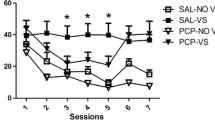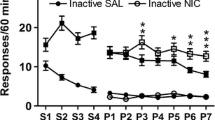Abstract
The effect of non-contingent priming injections of nicotine on the reinstatement of drug-seeking behaviour was studied in rats following the long-term extinction of nicotine self-administration. Male rats were trained to lever press for 0.03 mg/kg per infusion of intravenous nicotine. Nicotine maintained a robust self-administration behaviour (11.5±1.2; mean±SEM infusions/1-h session). When nicotine availability was discontinued, and only a non-contingent saline infusion was presented to the experimental subjects at the beginning of each daily session, responding for the drug-paired lever decreased to low values. After 4–13 sessions, responding extinguished. During this “extinction” period, non-contingent priming infusions of nicotine 0.001, 0.003, 0.01 or 0.03 mg/kg per infusion induced reinstatement of responsing for the drug-paired lever. The increased responding, compared with the corresponding previous day on saline, was observed at all four nicotine doses but was not statistically significant for the higher priming dose (0.03 mg/kg per infusion). These preliminary results indicate that nicotine priming is able to induce reinstatement of drug-seeking behaviour in rats similarly to other reinforcing drugs. The present findings show analogies with similar phenomena described in ex-smokers and support the addictive role of nicotine in tobacco smoking.
Similar content being viewed by others
References
Chornock WM, Stitzer ML, Gross J, Leischow S (1992) Experimental model of smoking re-exposure effects on relapse. Psychopharmacology 108:495–500
Corrigall WA (1992) A rodent model for nicotine self-administration. In: Boulton AA, Baker GB, Wu P (eds) Animal methods of drug addiction. Humana Press, Totowa, pp 315–344
Corrigall WA, Coen KM (1989) Nicotine maintains robust self-administration in rats on a limited-access schedule. Psychopharmacology 99:473–478
Corrigall WA, Herling S, Coen KM (1988) Evidence for opioid mechanisms in the behavioural effects of nicotine. Psychopharmacology 96:29–35
Davis WM, Smith GS (1976) Role of conditioned reinforcers in the initiation, maintenance and extinction of drug-seeking behavior. Pavlov J Biol Sci 11:222–236
de Wit H, Stewart J (1981) Reinstatement of cocaine-reinforced responding in the rat. Psychopharmacology 75:134–143
de Wit H, Stewart J (1983) Drug reinstatement of heroin-reinforced responding in the rat. Psychopharmacology 79:29–31
Gerber GJ, Stretch R (1975) Drug-induced reinstatement of extinguished self-administration behavior in monkeys. Pharmacol Biochem Behav 3:1055–1061
Goldberg SR, Spealman RD, Risner ME, Henningfield JE (1983) Control of behavior by intravenous nicotine injections in laboratory animals. Pharmacol Biochem Behav 19: 1011–1020
Hodgson R, Rankin H, Stickwell T (1979) Alcohol dependence and the priming effect. Behav Res Ther 17:379–387
Jaffe JH, Cascella NG, Kumor KM, Sherer MA (1989) Cocaine-induced cocaine craving. Psychopharmacology 97:59–64
Karoly AJ, Winger G, Ikomi F, Woods JH (1978) The reinforcing property of ethanol in the rhesus monkey. Psychopharmacology 58:19–25
Lane JD, Pickering CL, Hooper ML, Fagan K, Tyers MB, Emmett-Oglesby MW (1992) Failure of ondansetron to block the discriminative or reinforcing stimulus effects of cocaine in the rat. Drug Alcohol Depend 30:151–162
Lang WJ, Latiff AA, McQueen A, Singer G (1977) Self administration of nicotine with and without a food delivery schedule. Pharmacol Biochem Behav 7:65–70
Ludwig AM, Wikler A (1974) The first drink. Arch Gen Psychiatry 30:539–547
Markou A, Weiss F, Gold LH, Caine B, Schulteis G, Koob GG (1993) Animal models of drug craving. Psychopharmacology 112:163–182
Meyer RE (1988) Conditioning phenomena and the problem of relapse in opioid addicts and alcoholics. NIDA Res Monogr 84:161–179
Shaham Y, Rodaros D, Stewart J (1994) Reinstatement of heroin-reinforced behavior following long-term extinction: implications for the treatment of relapse to drug taking. Behav Pharmacol 5:360–364
Shiffman S (1986) A cluster-analytic classification of smoking relapse episodes. Addict Behav 11:295–307
Shiffman SM, Jarvik ME (1976) Smoking withdrawal symptoms in two weeks of abstinence. Psychopharmacology 50:35–39
Stewart J (1984) Reinstatement of heroin and cocaine self-administration behavior in the rat by intracerebral application of morphine in the ventral tegmental area. Pharmacol Biochem Behav 20:917–923
Stewart J, Wise RA (1992) Reinstatement of heroin self-administration habits: morphine prompts and naltrexone discourages renewed responding after extinction. Psychopharmacology 108:79–84
Stewart J, de Wit H, Eikelboom R (1984) Role of unconditioned and Conditioned drug effects in the self-administration of opiates and stimulants. Psychol Rev 91:251–268
Stolerman, IP, Jarvis MJ (1995) The scientific case that nicotine is addictive. Psychopharmacology 117:2–10
Stretch R, Gerber GJ (1973) Drug-induced reinstatement of amphetamine self-administration in monkeys. Can J Psychol 27:168–177
Stretch R, Gerber GJ, Wood SM (1971) Factors affecting behavior maintained by response-contingent intravanenous infusions of amphetamine in squirrel monkeys. Can J Physiol Pharmacol 49:581–589
Tessari M, Valerio E, Chiamulera C, Beardsley PM (1995) Nicotine reinforcement in rats with histories of cocaine self-administration. Psychopharmacology 121:282–283
US Department of Health and Human Services (1988) The health consequences of smoking: nicotine addiction. A Report of the Surgeon General, Office on Smoking and Health, Maryland
Wise RA, Murray A, Bozarth MA (1990) Bromocriptine self-administration and bromocriptine-reinstatement of cocaine-trained and heroin-trained lever pressing in rats. Psychopharmacology 100:355–360
Author information
Authors and Affiliations
Rights and permissions
About this article
Cite this article
Chiamulera, C., Borgo, C., Falchetto, S. et al. Nicotine reinstatement of nicotine self-administration after long-term extinction. Psychopharmacology 127, 102–107 (1996). https://doi.org/10.1007/BF02805981
Received:
Accepted:
Issue Date:
DOI: https://doi.org/10.1007/BF02805981




